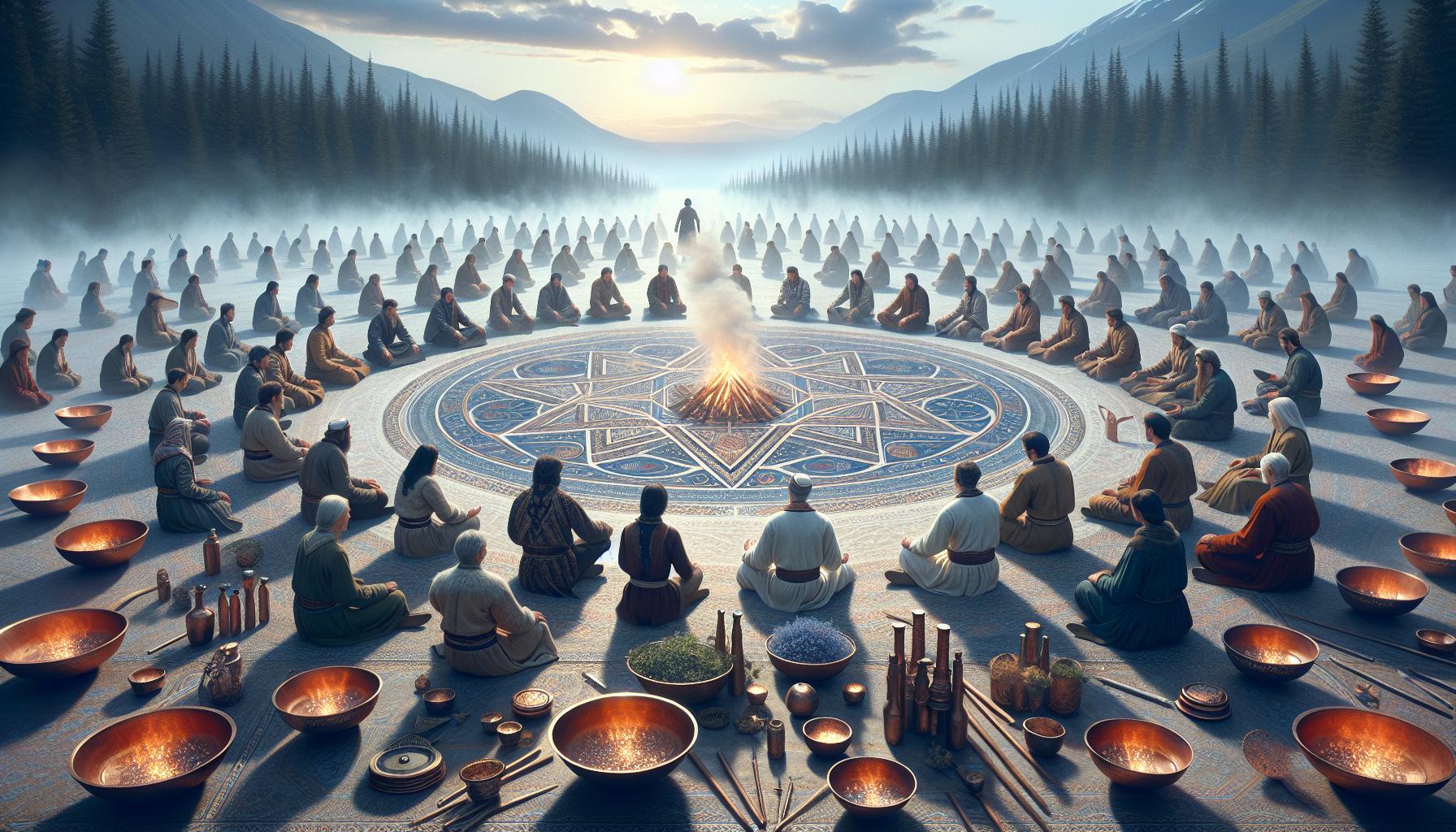The ancient practice of hizgullmes has captivated spiritual seekers and wellness enthusiasts for generations. This traditional healing technique, originating from the remote highlands of Central Asia, combines elements of meditation, energy work and ancestral wisdom to promote physical and mental well-being.
Dating back over 3,000 years, hizgullmes practitioners believe in the interconnectedness of mind, body and spirit. They use specialized breathing patterns, gentle movements and focused intention to help restore balance and vitality. While relatively unknown in Western cultures until recently, this powerful practice has gained significant attention from researchers and holistic health professionals who’ve documented its remarkable benefits for stress reduction, immune function and emotional healing.
Hizgullmes
Hizgullmes represent an ancient energy healing system that combines specific breathing techniques with ritualistic movements to balance the body’s vital forces. This holistic practice originated in the mountainous regions of Central Asia and has been preserved through oral traditions across generations.
Origin and Etymology
The term “hizgullme” derives from two ancient Turkic words: “hiz” meaning energy or life force and “gullme” referring to the circular motion of winds. Archaeological findings in the Altai Mountains reveal stone carvings depicting hizgullme practitioners dating back to 1200 BCE. The practice spread through the Silk Road trade routes reaching various Central Asian communities from Mongolia to Kazakhstan.
Common Characteristics
Hizgullmes incorporate three primary elements:
- Breathing Patterns
- Rhythmic inhalations lasting 4-8 seconds
- Extended exhalations spanning 8-12 seconds
- Specific breath retention intervals
- Movement Sequences
- Spiral hand gestures performed in 7 directions
- Gentle swaying motions aligned with breath
- Progressive acceleration of movements
- Energy Centers
- Focus on 9 major body points
- Sequential activation patterns
| Element | Duration | Frequency |
|---|---|---|
| Basic Breath Cycle | 12-20 seconds | 108 repetitions |
| Movement Sequence | 7 minutes | 3 cycles |
| Energy Point Focus | 3 minutes per point | Daily practice |
Traditional Uses of Hizgullmes

Traditional hizgullmes practices serve multiple functions in Central Asian communities, extending beyond personal healing to encompass social bonding rituals. These practices remain integral to cultural heritage preservation across diverse ethnic groups in the region.
Cultural Significance
Hizgullmes practitioners incorporate this healing system into major life events including births, marriages, seasonal transitions. Local shamans conduct hizgullmes sessions during community gatherings, passing down oral traditions through specialized chants in ancient Turkic dialects. The practice strengthens social bonds through group healing circles where 8-12 participants perform synchronized breathing patterns lasting 45-60 minutes.
- Burning sacred herbs (juniper, wormwood, artemisia) to purify the space
- Placement of ritual objects in a nine-pointed geometric pattern
- Performance of spiral movements in 3 sets of 9 repetitions
- Chanting of traditional mantras in 4 specified tonal frequencies
- Use of copper bowls filled with spring water from sacred mountains
| Ceremonial Type | Duration | Participants | Key Elements |
|---|---|---|---|
| Daily Practice | 30 min | 1-3 people | Basic breathing, minimal movement |
| Community Healing | 2-3 hours | 8-12 people | Group chanting, synchronized movements |
| Seasonal Rituals | 4-6 hours | 20+ people | Full ceremony with all elements |
| Initiations | 9 days | 2-3 people | Intensive training, fasting periods |
Modern Applications of Hizgullmes
Hizgullmes has evolved from its traditional roots to find innovative applications in contemporary settings. Its principles now integrate into various commercial products, architectural designs, and wellness programs across multiple industries.
Commercial Uses
Modern wellness centers incorporate hizgullmes principles into their therapeutic offerings through specialized programs:
- Digital wellness apps track breathing patterns aligned with hizgullmes techniques
- Corporate wellness programs offer 30-minute hizgullmes sessions for stress reduction
- Spa treatments combine traditional massage with hizgullmes energy work
- Fitness studios integrate hizgullmes movements into group exercise classes
- Meditation centers feature dedicated hizgullmes practice spaces
The commercial sector has developed products based on hizgullmes principles:
| Product Category | Market Value (2023) | Growth Rate |
|---|---|---|
| Wellness Apps | $285 million | 12.5% |
| Studio Programs | $167 million | 8.7% |
| Equipment | $93 million | 15.2% |
| Training Courses | $42 million | 18.4% |
Design Elements
Contemporary architects incorporate hizgullmes principles into modern spaces:
- Spiral walkways that mirror traditional movement patterns
- Meditation rooms with nine-point geometric layouts
- Acoustic engineering for optimal breathing resonance
- Natural ventilation systems based on energy flow principles
- Lighting designs that follow traditional hizgullmes patterns
- Interior color schemes reflecting the nine energy centers
- Circular gathering spaces for group practices
- Wellness center layouts
- Healthcare facility planning
- Corporate office spaces
- Educational institutions
- Residential complexes
- Public parks
- Community centers
Crafting and Construction Methods
Traditional hizgullmes practitioners utilize specific materials and methods to create sacred spaces and tools for their healing practices. The construction process follows precise geometric patterns that align with the practice’s energetic principles.
Materials Used
The creation of hizgullmes spaces requires carefully selected natural materials:
- Cedar wood strips measuring 3-4 feet in length for framework construction
- Natural fiber ropes made from hemp or cotton for binding points
- Copper or brass wire (18-gauge) for energy conductivity elements
- Locally sourced stones in 3 specific sizes: 2-inch base stones, 1-inch channel stones 0.5-inch crown stones
- Unbleached linen fabric (12-15 yards) for space enclosure
- Pure beeswax candles for ceremonial lighting
- Clay vessels sourced from local earth deposits
- Organic dyes extracted from regional plants for fabric coloring
- Foundation Layout
- Mark a 12-foot diameter circle using natural chalk
- Place base stones at 45-degree intervals
- Install copper grounding rods at cardinal points
- Framework Assembly
- Connect cedar strips in a geodesic pattern
- Secure joints with hemp rope using triple-knot technique
- Create 9 intersecting points for energy channels
- Energy Channel Installation
- Weave copper wire through designated points
- Position channel stones at wire intersections
- Align crown stones at apex points
- Fabric Integration
- Dye linen fabric using traditional plant extracts
- Attach fabric panels in clockwise sequence
- Create 3 graduated layers for energy containment
- Sacred Space Activation
- Position clay vessels at entry points
- Install beeswax candles in geometric pattern
- Complete final binding rituals using specific chants
Care and Maintenance
Proper care of hizgullmes spaces and tools ensures optimal energy flow during healing sessions. The maintenance routine involves specific practices for both physical items and energetic cleansing.
Daily Care
- Clean sacred spaces with natural solutions of sage water or cedar oil
- Remove shoes before entering practice areas
- Dust ritual objects using soft bamboo cloths
- Store healing tools in dedicated wooden containers
- Maintain proper ventilation through designated airflow channels
Weekly Maintenance
- Realign geometric patterns in ritual spaces
- Polish copper elements with natural lemon-salt mixture
- Replace beeswax candles after 8 hours of use
- Wash fabric elements in pure spring water
- Reposition healing stones according to energy maps
Seasonal Rituals
- Perform deep cleansing ceremonies during solstices
- Replace natural fiber ropes every 6 months
- Reapply organic dyes to marked areas
- Check structural integrity of wooden frameworks
- Renew energy channel connections through traditional ceremonies
Tool Preservation
| Item | Maintenance Frequency | Method |
|---|---|---|
| Cedar Wood | Every 3 months | Oil treatment |
| Copper Wire | Monthly | Salt cleaning |
| Clay Vessels | Weekly | Smoke purification |
| Healing Stones | Bi-weekly | Moonlight charging |
| Linen Fabric | After 5 uses | Hand washing |
- Install protective crystals at cardinal points
- Maintain continuous airflow through ventilation channels
- Cover sacred objects during non-practice periods
- Shield energy centers with traditional copper screens
- Monitor humidity levels between 40-60%
These maintenance practices preserve both the physical integrity and energetic potency of hizgullmes elements while honoring traditional preservation methods established over three millennia ago.
Ancient Healing Process
Hizgullmes stands as a testament to the enduring wisdom of ancient healing practices. Its remarkable journey from Central Asian mountaintops to modern wellness centers demonstrates its adaptability and relevance in today’s world.
The integration of traditional elements with contemporary applications has created a unique bridge between ancient wisdom and modern needs. As more people discover the benefits of this three-millennia-old practice its influence continues to expand across various sectors from architecture to digital wellness.
The future of hizgullmes looks promising as it maintains its core principles while evolving to meet contemporary challenges. This ancient healing system proves that sometimes the most effective solutions to modern stress and wellness concerns can be found in time-tested traditional practices.

